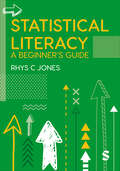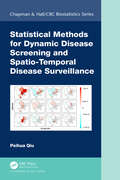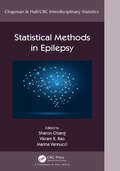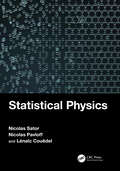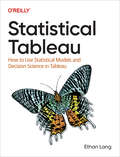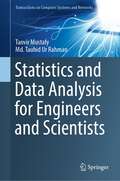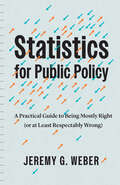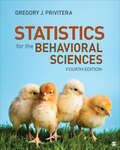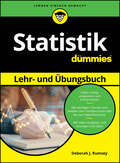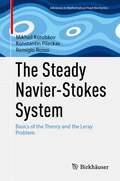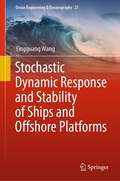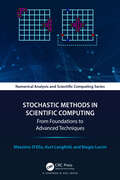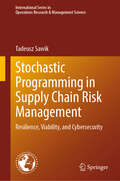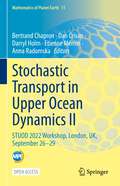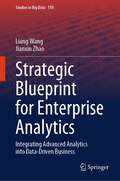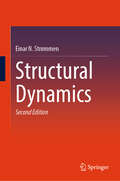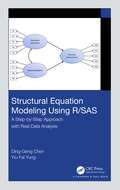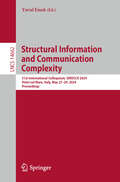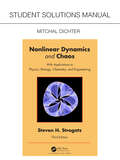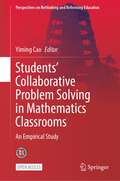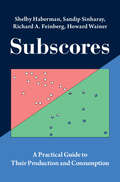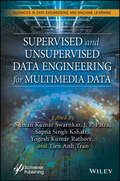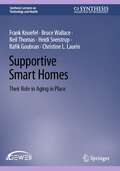- Table View
- List View
Statistical Literacy: A Beginner′s Guide
by Rhys Christopher JonesIn an increasingly data-centric world, we all need to know how to read and interpret statistics. But where do we begin? This book breaks statistical terms and concepts down in a clear, straightforward way. From understanding what data are telling you to exploring the value of good storytelling with numbers, it equips you with the information and skills you need to become statistically literate. It also: Dispels misconceptions about the nature of statistics to help you avoid common traps. Helps you put your learning into practice with over 60 Tasks and Develop Your Skills activities. Draws on real-world research to demonstrate the messiness of data – and show you a path through it. Approachable and down to earth, this guide is aimed at undergraduates across the social sciences, psychology, business and beyond who want to engage confidently with quantitative methods or statistics. It forms a reassuring aid for anyone looking to understand the foundations of statistics before their course advances, or as a refresher on key content.
Statistical Literacy: A Beginner′s Guide
by Rhys Christopher JonesIn an increasingly data-centric world, we all need to know how to read and interpret statistics. But where do we begin? This book breaks statistical terms and concepts down in a clear, straightforward way. From understanding what data are telling you to exploring the value of good storytelling with numbers, it equips you with the information and skills you need to become statistically literate. It also: Dispels misconceptions about the nature of statistics to help you avoid common traps. Helps you put your learning into practice with over 60 Tasks and Develop Your Skills activities. Draws on real-world research to demonstrate the messiness of data – and show you a path through it. Approachable and down to earth, this guide is aimed at undergraduates across the social sciences, psychology, business and beyond who want to engage confidently with quantitative methods or statistics. It forms a reassuring aid for anyone looking to understand the foundations of statistics before their course advances, or as a refresher on key content.
Statistical Methods for Dynamic Disease Screening and Spatio-Temporal Disease Surveillance (Chapman & Hall/CRC Biostatistics Series)
by Peihua QiuDisease screening and disease surveillance (DSDS) constitute two critical areas in public health, each presenting distinctive challenges primarily due to their sequential decision-making nature and complex data structures. Statistical Methods for Dynamic Disease Screening and Spatio-Temporal Disease Surveillance explores numerous recent analytic methodologies that enhance traditional techniques. The author, a prominent researcher specializing in innovative sequential decision-making techniques, demonstrates how these novel methods effectively address the challenges of DSDS.After a concise introduction that lays the groundwork for comprehending the challenges inherent in DSDS, the book delves into fundamental statistical concepts and methods relevant to DSDS. This includes exploration of statistical process control (SPC) charts specifically crafted for sequential decision-making purposes. The subsequent chapters systematically outline recent advancements in dynamic screening system (DySS) methods, fine-tuned for effective disease screening. Additionally, the text covers both traditional and contemporary analytic methods for disease surveillance. It further introduces two recently developed R packages designed for implementing DySS methods and spatio-temporal disease surveillance techniques pioneered by the author's research team.Features• Presents Recent Analytic Methods for DSDS: The book introduces analytic methods for DSDS based on SPC charts. These methods effectively utilize all historical data, accommodating the complex data structure inherent in sequential decision-making processes.• Introduces Recent R Packages: Two recent R packages, DySS and SpTe2M, are introduced. The book not only presents these packages but also demonstrates key DSDS methods using them.• Examines Recent Research Results: The text delves into the latest research findings across various domains, including dynamic disease screening, nonparametric spatio-temporal data modeling and monitoring, and spatio-temporal disease surveillance.• Accessible Description of Methods: Major methods are described in a manner accessible to individuals without advanced knowledge in mathematics and statistics. The goal is to facilitate a clear understanding of ideas and easy implementation.• Real-Data Examples: To aid comprehension, the book provides several real-data examples illustrating key concepts and methods.• Hands-on Exercises: Each chapter includes exercises to encourage hands-on practice, allowing readers to engage directly with the presented methods.
Statistical Methods in Epilepsy (Chapman & Hall/CRC Interdisciplinary Statistics)
by Sharon Chiang Vikram R. Rao Marina VannucciEpilepsy research promises new treatments and insights into brain function, but statistics and machine learning are paramount for extracting meaning from data and enabling discovery. Statistical Methods in Epilepsy provides a comprehensive introduction to statistical methods used in epilepsy research. Written in a clear, accessible style by leading authorities, this textbook demystifies introductory and advanced statistical methods, providing a practical roadmap that will be invaluable for learners and experts alike.Topics include a primer on version control and coding, pre-processing of imaging and electrophysiological data, hypothesis testing, generalized linear models, survival analysis, network analysis, time-series analysis, spectral analysis, spatial statistics, unsupervised and supervised learning, natural language processing, prospective trial design, pharmacokinetic and pharmacodynamic modeling, and randomized clinical trials.Features: Provides a comprehensive introduction to statistical methods employed in epilepsy research Divided into four parts: Basic Processing Methods for Data Analysis; Statistical Models for Epilepsy Data Types; Machine Learning Methods; and Clinical Studies Covers methodological and practical aspects, as well as worked-out examples with R and Python code provided in the online supplement Includes contributions by experts in the field The handbook targets clinicians, graduate students, medical students, and researchers who seek to conduct quantitative epilepsy research. The topics covered extend broadly to quantitative research in other neurological specialties and provide a valuable reference for the field of neurology.
Statistical Physics
by Nicolas Sator Nicolas Pavloff Lenaic CouedelThis book presents an introduction to the main concepts of statistical physics, followed by applications to specific problems and more advanced concepts, selected for their pedagogical or practical interest. Particular attention has been devoted to the presentation of the fundamental aspects, including the foundations of statistical physics, as well as to the discussion of important physical examples. Comparison of theoretical results with the relevant experimental data (with illustrative curves) is present through the entire textbook. This aspect is facilitated by the broad range of phenomena pertaining to statistical physics, providing example issues from domains as varied as the physics of classical and quantum liquids, condensed matter, liquid crystals, magnetic systems, astrophysics, atomic and molecular physics, superconductivity and many more. This textbook is intended for graduate students (MSc and PhD) and for those teaching introductory or advanced courses on statistical physics. Key Features: A rigorous and educational approach of statistical physics illustrated with concrete examples. A clear presentation of fundamental aspects of statistical physics. Many exercises with detailed solutions. Nicolas Sator is Associate Professor at Sorbonne University, Paris, France. He is a member of the Laboratory of Theoretical Physics of Condensed Matter (LPTMC) and his research focuses on the physics of liquids. Nicolas Pavloff is Professor at Paris-Saclay University, France. He is a member of Laboratoire de Physique Théorique et Modèles Statistiques (LPTMS) and his domain of research is quantum fluid theory. Lénaïc Couëdel is Professor at the University of Sasktchewan, Saskatoon, Canada and researcher at CNRS, France. His research area is plasma physics with a focus on complex plasma crystals.
Statistical Tableau: How To Use Statistical Models And Decision Science In Tableau
by Ethan LangIn today's data-driven world, understanding statistical models is crucial for effective analysis and decision making. Whether you're a beginner or an experienced user, this book equips you with the foundational knowledge to grasp and implement statistical models within Tableau. Gain the confidence to speak fluently about the models you employ, driving adoption of your insights and analysis across your organization.As AI continues to revolutionize industries, possessing the skills to leverage statistical models is no longer optional—it's a necessity. Stay ahead of the curve and harness the full potential of your data by mastering the ability to interpret and utilize the insights generated by these models.Whether you're a data enthusiast, analyst, or business professional, this book empowers you to navigate the ever-evolving landscape of data analytics with confidence and proficiency. Start your journey toward data mastery today.In this book, you will learn:The basics of foundational statistical modeling with TableauHow to prove your analysis is statistically significantHow to calculate and interpret confidence intervalsBest practices for incorporating statistics into data visualizationsHow to connect external analytics resources from Tableau using R and Python
Statistics and Data Analysis for Engineers and Scientists (Transactions on Computer Systems and Networks)
by Tanvir Mustafy Md. Tauhid RahmanThis textbook summarizes the different statistical, scientific, and financial data analysis methods for users ranging from a high school level to a professional level. It aims to combine the data analysis methods using three different programs—Microsoft Excel, SPSS, and MATLAB. The book combining the different data analysis tools is a unique approach. The book presents a variety of real-life problems in data analysis and machine learning, delivering the best solution. Analysis methods presented in this book include but are not limited to, performing various algebraic and trigonometric operations, regression modeling, and correlation, as well as plotting graphs and charts to represent the results. Fundamental concepts of applied statistics are also explained here, with illustrative examples. Thus, this book presents a pioneering solution to help a wide range of students, researchers, and professionals learn data processing, interpret different findings derived from the analyses, and apply them to their research or professional fields. The book also includes worked examples of practical problems. The primary focus behind designing these examples is understanding the concepts of data analysis and how it can solve problems. The chapters include practice exercises to assist users in enhancing their skills to execute statistical analysis calculations using software instead of relying on tables for probabilities and percentiles in the present world.
Statistics for Public Policy: A Practical Guide to Being Mostly Right (or at Least Respectably Wrong)
by Jeremy G. WeberA long-overdue guide on how to use statistics to bring clarity, not confusion, to policy work. Statistics are an essential tool for making, evaluating, and improving public policy. Statistics for Public Policy is a crash course in wielding these unruly tools to bring maximum clarity to policy work. Former White House economist Jeremy G. Weber offers an accessible voice of experience for the challenges of this work, focusing on seven core practices: Thinking big-picture about the role of data in decisions Critically engaging with data by focusing on its origins, purpose, and generalizability Understanding the strengths and limits of the simple statistics that dominate most policy discussions Developing reasons for considering a number to be practically small or large Distinguishing correlation from causation and minor causes from major causes Communicating statistics so that they are seen, understood, and believed Maintaining credibility by being right (or at least respectably wrong) in every setting Statistics for Public Policy dispenses with the opacity and technical language that have long made this space impenetrable; instead, Weber offers an essential resource for all students and professionals working at the intersections of data and policy interventions. This book is all signal, no noise.
Statistics for the Behavioral Sciences
by Gregory J. PriviteraRecipient of the 2024 Textbook & Academic Authors Association (TAA) Textbook Excellence Award This award recognizes excellence in current textbooks and learning materials. Statistics for the Behavioral Sciences by award-winning author Gregory Privitera aims to not only inspire students to use statistics properly to better understand the world around them, but also to develop the skills to be lab-ready in applied research settings. Incorporating examples from current, relatable research throughout the text, Privitera shows students that statistics can be relevant, interesting, and accessible. Robust pedagogy encourages students to continually check their comprehension and hone their skills by working through problem sets throughout the text, including exercises that seamlessly integrate SPSS. This new Fourth Edition gives students a greater awareness of the best practices of analysis in the behavioral sciences, with a focus on transparency in recording, managing, analyzing, and interpreting data. Included with this title: LMS Cartridge: Import this title′s instructor resources into your school′s learning management system (LMS) and save time. Don′t use an LMS? You can still access all of the same online resources for this title via the password-protected Instructor Resource Site. Learn more.
Statistics for the Behavioral Sciences
by Gregory J. PriviteraRecipient of the 2024 Textbook & Academic Authors Association (TAA) Textbook Excellence Award This award recognizes excellence in current textbooks and learning materials. Statistics for the Behavioral Sciences by award-winning author Gregory Privitera aims to not only inspire students to use statistics properly to better understand the world around them, but also to develop the skills to be lab-ready in applied research settings. Incorporating examples from current, relatable research throughout the text, Privitera shows students that statistics can be relevant, interesting, and accessible. Robust pedagogy encourages students to continually check their comprehension and hone their skills by working through problem sets throughout the text, including exercises that seamlessly integrate SPSS. This new Fourth Edition gives students a greater awareness of the best practices of analysis in the behavioral sciences, with a focus on transparency in recording, managing, analyzing, and interpreting data. Included with this title: LMS Cartridge: Import this title′s instructor resources into your school′s learning management system (LMS) and save time. Don′t use an LMS? You can still access all of the same online resources for this title via the password-protected Instructor Resource Site. Learn more.
Statistik Lehr- und Übungsbuch für Dummies (Für Dummies)
by Deborah J. RumseyIhr praktischer Einstieg in die Statistik Statistik ist nicht immer ganz einfach, aber sehr nützlich. Der Schlüssel zum Erfolg heißt: erst verstehen und dann üben, üben, üben. Deborah Rumsey erklärt Ihnen die notwendigen Grundbegriffe und erläutert die wichtigsten statistischen Konzepte. Dabei kommt sie fast ohne Formeln aus und schafft einen Bezug zwischen Theorie und Praxis. Sie lernen die verschiedenen grafischen Darstellungsmöglichkeiten von statistischem Material kennen und erfahren, wie Sie Ihre Ergebnisse richtig auswerten. Mit Übungen zu allen Themengebieten können Sie dann das erlernte Wissen festigen. Sie erfahren Wie Sie brauchbare Daten erheben Wie Sie Diagramme erstellen und interpretieren Wie Sie mit Wahrscheinlichkeitsmodellen komplizierte Fragen schnell beantworten Wie Sie einen Hypothesentest aufstellen und durchführen
The Steady Navier-Stokes System: Basics of the Theory and the Leray Problem (Advances in Mathematical Fluid Mechanics)
by Mikhail Korobkov Konstantin Pileckas Remigio RussoThis book provides a successful solution to one of the central problems of mathematical fluid mechanics: the Leray’s problem on existence of a solution to the boundary value problem for the stationary Navier—Stokes system in bounded domains under sole condition of zero total flux. This marks the culmination of the authors' work over the past few years on this under-explored topic within the study of the Navier—Stokes equations. This book will be the first major work on the Navier—Stokes equations to explore Leray’s problem in detail. The results are presented with detailed proofs, as are the history of the problem and the previous approaches to finding a solution to it. In addition, for the reader’s convenience and for the self-sufficiency of the text, the foundations of the mathematical theory for incompressible fluid flows described by the steady state Stokes and Navier—Stokes systems are presented. For researchers in this active area, this book will be a valuable resource.
Stochastic Dynamic Response and Stability of Ships and Offshore Platforms (Ocean Engineering & Oceanography #27)
by Yingguang WangThis textbook investigates in detail the methods for stochastic dynamic response and stability analyses of nonlinear systems (especially ships and ocean engineering systems), elucidating the advantages and disadvantages of each of the methods (the statistical linearization method, the perturbation method, the Monte Carlo Simulation method, the numerical path integration method, the global geometric method and the first passage theory). Studies on stochastic dynamic analysis of nonlinear systems have attracted engineers and scientists from various disciplines, such as aeronautical, civil, mechanical and ocean engineering. Pursuing a systematic approach, this book establishes a fundamental framework for this topic, while emphasizing the importance of accurate and efficient analysis as well as the significant influence of choosing a suitable method in the design and optimization of various nonlinear engineering systems (especially ships and ocean engineering systems).The textbook is intended for upper undergraduate and graduate students who are interested in advanced dynamic analysis technologies, researchers investigating nonlinear systems under stochastic dynamic excitations, and civil/mechanical/structural/ocean engineers working on designing and optimization of real-world nonlinear engineering systems. The basis of English translation of this book from its Chinese original manuscript was done with the help of artificial intelligence. A subsequent human revision of the content was done by the author.
Stochastic Methods in Scientific Computing: From Foundations to Advanced Techniques (Chapman & Hall/CRC Numerical Analysis and Scientific Computing Series)
by Massimo D'Elia Kurt Langfeld Biagio LuciniStochastic Methods in Scientific Computing: From Foundations to Advanced Techniques introduces the reader to advanced concepts in stochastic modelling, rooted in an intuitive yet rigorous presentation of the underlying mathematical concepts. A particular emphasis is placed on illuminating the underpinning Mathematics, and yet have the practical applications in mind. The reader will find valuable insights into topics ranging from Social Sciences and Particle Physics to modern-day Computer Science with Machine Learning and AI in focus. The book also covers recent specialised techniques for notorious issues in the field of stochastic simulations, providing a valuable reference for advanced readers with an active interest in the field.Features Self-contained, starting from the theoretical foundations and advancing to the most recent developments in the field Suitable as a reference for post-graduates and researchers or as supplementary reading for courses in numerical methods, scientific computing, and beyond Interdisciplinary, laying a solid ground for field-specific applications in finance, physics and biosciences on common theoretical foundations Replete with practical examples of applications to classic and current research problems in various fields.
Stochastic Programming in Supply Chain Risk Management: Resilience, Viability, and Cybersecurity (International Series in Operations Research & Management Science #359)
by Tadeusz SawikThis book offers a novel multi-portfolio approach and stochastic programming formulations for modeling and solving contemporary supply chain risk management problems. The focus of the book is on supply chain resilience under propagated disruptions, supply chain viability under severe crises, and supply chain cybersecurity under direct and indirect cyber risks. The content is illustrated with numerous computational examples, some of which are modeled on real-world supply chains subject to severe multi-regional or global crises, such as pandemics. In the computational examples, the proposed stochastic programming models are solved using an advanced algebraic modeling language AMPL and GUROBI solver. The book seamlessly continues the journey begun in the author’s previously published book “Supply Chain Disruption Management: Using Stochastic Mixed Integer Programming.” It equips readers with the knowledge, tools, and managerial insights needed to effectively model and address modern supply chain risk management challenges. As such, the book is designed for practitioners and researchers who are interested in supply chain risk management. Master’s and Ph.D. students in disciplines like supply chain management, operations research, industrial engineering, applied mathematics, and computer science will also find the book a valuable resource.
Stochastic Transport in Upper Ocean Dynamics II: STUOD 2022 Workshop, London, UK, September 26–29 (Mathematics of Planet Earth #11)
by Bertrand Chapron Dan Crisan Darryl Holm Etienne Mémin Anna RadomskaThis open access proceedings volume brings selected, peer-reviewed contributions presented at the Third Stochastic Transport in Upper Ocean Dynamics (STUOD) 2022 Workshop, held virtually and in person at the Imperial College London, UK, September 26–29, 2022. The STUOD project is supported by an ERC Synergy Grant, and led by Imperial College London, the National Institute for Research in Computer Science and Automatic Control (INRIA) and the French Research Institute for Exploitation of the Sea (IFREMER). The project aims to deliver new capabilities for assessing variability and uncertainty in upper ocean dynamics. It will provide decision makers a means of quantifying the effects of local patterns of sea level rise, heat uptake, carbon storage and change of oxygen content and pH in the ocean. Its multimodal monitoring will enhance the scientific understanding of marine debris transport, tracking of oil spills and accumulation of plastic in the sea.All topics of these proceedings are essential to the scientific foundations of oceanography which has a vital role in climate science. Studies convened in this volume focus on a range of fundamental areas, including:Observations at a high resolution of upper ocean properties such as temperature, salinity, topography, wind, waves and velocity;Large scale numerical simulations;Data-based stochastic equations for upper ocean dynamics that quantify simulation error;Stochastic data assimilation to reduce uncertainty.These fundamental subjects in modern science and technology are urgently required in order to meet the challenges of climate change faced today by human society. This proceedings volume represents a lasting legacy of crucial scientific expertise to help meet this ongoing challenge, for the benefit of academics and professionals in pure and applied mathematics, computational science, data analysis, data assimilation and oceanography.
Strategic Blueprint for Enterprise Analytics: Integrating Advanced Analytics into Data-Driven Business (Studies in Big Data #150)
by Liang Wang Jianxin ZhaoThis book is a comprehensive guide for professionals, leaders, and academics seeking to unlock the power of data and analytics in the modern business landscape. It delves deeply into the strategic, architectural, and managerial aspects of implementing enterprise analytics (EA) systems in large enterprises. The book is meticulously structured into three parts. Part 1 lays the foundation for adaptable architecture in EA. Part 2 explores technical considerations: data, cloud platforms, and AI solutions. The final part focuses on strategy execution, investment, and risk management. Acting as a comprehensive guide, the book enables the creation of robust EA capabilities that foster growth, optimize operations, and keep pace with EA's dynamic world. Whether readers are leaders harnessing data's potential, practitioners navigating analytics, or academics exploring this evolving domain, this book provides insights and knowledge to guide readers toward a thriving, data-driven future.
Structural Dynamics
by Einar N. StrømmenThe first part of this book covers the general theory of structural dynamics, in a calculous format as well as a finite element formulation. Secondly, it contains methods of eigenvalue calculations of civil engineering structural systems. And third, it contains a major part covering dynamic displacement response calculations as induced by earthquake, turbulent wind, vortex shedding and moving vehicles, enabling the designer to evaluate structural safety from the effects of fluctuating internal forces.The general theory contains comprehensive development of the principle of virtual displacements, as well as the Galerkin solution to eigenvalue problems. A separate chapter has been dedicated to the suspension bridge. The theory of single or multiple tuned mass dampers is included, a theory not presented elsewhere.The book contains a chapter covering the theory of structural damping, as well as comprehensive data of the structural damping properties that are necessary forany dynamic response calculation. The book is intended for students as well as practising engineers. It contains numerous relevant examples, covering numerical solutions that are well suited for computer programming.
Structural Equation Modeling Using R/SAS: A Step-by-Step Approach with Real Data Analysis
by Ding-Geng Chen Yiu-Fai YungThere has been considerable attention to making the methodologies of structural equation modeling available to researchers, practitioners, and students along with commonly used software. Structural Equation Modelling Using R/SAS aims to bring it all together to provide a concise point-of-reference for the most commonly used structural equation modeling from the fundamental level to the advanced level. This book is intended to contribute to the rapid development in structural equation modeling and its applications to real-world data. Straightforward explanations of the statistical theory and models related to structural equation models are provided, using a compilation of a variety of publicly available data, to provide an illustration of data analytics in a step-by-step fashion using commonly used statistical software of R and SAS. This book is appropriate for anyone who is interested in learning and practicing structural equation modeling, especially in using R and SAS. It is useful for applied statisticians, data scientists and practitioners, applied statistical analysts and scientists in public health, and academic researchers and graduate students in statistics, whilst also being of use to R&D professionals/practitioners in industry and governmental agencies. Key Features: Extensive compilation of commonly used structural equation models and methods from fundamental to advanced levels Straightforward explanations of the theory related to the structural equation models Compilation of a variety of publicly available data Step-by-step illustrations of data analysis using commonly used statistical software R and SAS Data and computer programs are available for readers to replicate and implement the new methods to better understand the book contents and for future applications Handbook for applied statisticians and practitioners
Structural Information and Communication Complexity: 31st International Colloquium, SIROCCO 2024, Vietri sul Mare, Italy, May 27–29, 2024, Proceedings (Lecture Notes in Computer Science #14662)
by Yuval EmekThis book constitutes the refereed proceedings of the 31th International Colloquium on Structural Information and Communication Complexity, SIROCCO 2024, held in Haifa, Israel in May 2024. The 24 full papers and 6 short papers presented in this book were carefully reviewed and selected from 49 submissions. SIROCCO is devoted to the study of the interplay between structural knowledge, communication, and computing in decentralized systems of multiple communicating entities. Special emphasis is given to innovative approaches leading to better understanding of the relationship between computing and communication.
Student Solutions Manual for Non Linear Dynamics and Chaos: With Applications to Physics, Biology, Chemistry, and Engineering
by Mitchal DichterThis official Student Solutions Manual includes solutions to the odd-numbered exercises featured in the third edition of Steven Strogatz's classic text Nonlinear Dynamics and Chaos: With Applications to Physics, Biology, Chemistry, and Engineering. The textbook and accompanying Student Solutions Manual are aimed at newcomers to nonlinear dynamics and chaos, especially students taking a first course in the subject. Complete with graphs and worked-out solutions, this manual demonstrates techniques for students to analyze differential equations, bifurcations, chaos, fractals, and other subjects Strogatz explores in his popular book.
Students’ Collaborative Problem Solving in Mathematics Classrooms: An Empirical Study (Perspectives on Rethinking and Reforming Education)
by Yiming CaoThis open access book provides key insights into the social fundamentals of learning and indications of social interactive modes conducive and restrictive of that learning in China. Combining theoretical and technical advances in an innovative research design, this book focuses on collaborative problem solving in mathematics to increase the visibility of social interactions in teachers’ designing, students’ learning and teachers’ instructional intervention. It also explores students’ cognitive and social interaction as well as teacher intervention in students’ group collaboration.
Subscores: A Practical Guide to Their Production and Consumption
by null Shelby Haberman null Sandip Sinharay null Richard A. Feinberg null Howard WainerThis authoritative guide directs consumers and users of test scores on when and how to provide subscores and how to make informed decisions based on them. The book is designed to be accessible to practitioners and score users with varying levels of technical expertise, from executives of testing organizations and students who take tests to graduate students in educational measurement, psychometricians, and test developers. The theoretical background required to evaluate subscores and improve them are provided alongside examples of tests with subscores to illustrate their use and misuse. The first chapter covers the history of tests, subtests, scores, and subscores. Later chapters go into subscore reporting, evaluating and improving the quality of subscores, and alternatives to subscores when they are not appropriate. This thorough introduction to the existing research and best practices will be useful to graduate students, researchers, and practitioners.
Supervised and Unsupervised Data Engineering for Multimedia Data
by Suman Kumar Swarnkar J P Patra Sapna Singh Kshatri Yogesh Kumar Rathore Tien Anh TranSUPERVISED and UNSUPERVISED DATA ENGINEERING for MULTIMEDIA DATA Explore the cutting-edge realms of data engineering in multimedia with Supervised and Unsupervised Data Engineering for Multimedia Data, where expert contributors delve into innovative methodologies, offering invaluable insights to empower both novices and seasoned professionals in mastering the art of manipulating multimedia data with precision and efficiency. Supervised and Unsupervised Data Engineering for Multimedia Data presents a groundbreaking exploration into the intricacies of handling multimedia data through the lenses of both supervised and unsupervised data engineering. Authored by a team of accomplished experts in the field, this comprehensive volume serves as a go-to resource for data scientists, computer scientists, and researchers seeking a profound understanding of cutting-edge methodologies. The book seamlessly integrates theoretical foundations with practical applications, offering a cohesive framework for navigating the complexities of multimedia data. Readers will delve into a spectrum of topics, including artificial intelligence, machine learning, and data analysis, all tailored to the challenges and opportunities presented by multimedia datasets. From foundational principles to advanced techniques, each chapter provides valuable insights, making this book an essential guide for academia and industry professionals alike. Whether you’re a seasoned practitioner or a newcomer to the field, Supervised and Unsupervised Data Engineering for Multimedia Data illuminates the path toward mastery in manipulating and extracting meaningful insights from multimedia data in the modern age.
Supportive Smart Homes: Their Role in Aging in Place (Synthesis Lectures on Technology and Health)
by Frank Knoefel Bruce Wallace Neil Thomas Heidi Sveistrup Rafik Goubran Christine L. LaurinSignificant health-industry human resource needs increase the reliance on family and friends to support older adults hoping to age in place. This book explores how recent improvements in integrated home technologies have the potential to address those challenges. The book considers how embedded home sensors can be used to monitor the health and wellbeing of older adults and how that can be used to assist with supporting safety and well-being. The content is designed to help multiple stakeholders in the supportive smart home space to better understand the complexity of this field and the need for transdisciplinary collaboration. These stakeholders include the older adults who will benefit from supportive smart home technology; informal and formal caregiver and healthcare professionals concerned about the older adult’s well-being; researchers from multiple disciplines in the supportive smart home area and their funders; companies looking to develop solutions and services or expand their offerings; policy makers who want to ensure privacy and equity in access and a successful integration of these technologies into the evolving health and social services sectors; and students, the future leaders in AgeTech. Overall, the intent of the book is to inspire engineers, computer scientists, industrial designers, clinicians and healthcare providers, social scientists, students, policy makers, and older adults and their caregivers to collaborate in advancing the supportive smart home space to develop more options for aging in place.
